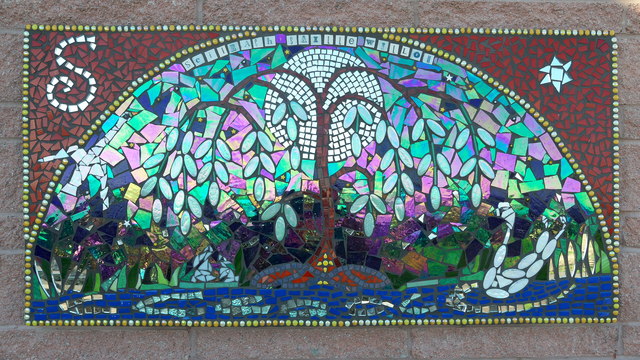The letter S in the Celtic Alphabet Mosaic Trail, Fortrose Academy
Introduction
The photograph on this page of The letter S in the Celtic Alphabet Mosaic Trail, Fortrose Academy by Julian Paren as part of the Geograph project.
The Geograph project started in 2005 with the aim of publishing, organising and preserving representative images for every square kilometre of Great Britain, Ireland and the Isle of Man.
There are currently over 7.5m images from over 14,400 individuals and you can help contribute to the project by visiting https://www.geograph.org.uk

Image: © Julian Paren Taken: 21 Jan 2017
The Letter S - on the Celtic Tree Alphabet Mosaic Trail Eighteen different community groups from across the Black Isle took part in this project in 2013, each taking a letter from the Celtic tree alphabet and creating a design inspired by that tree, its associated folklore, flora and fauna. The Letter S lies on the wall of Fortrose Academy beside the entrance to Fortrose Library. S is for the Willow, Tree. Celtic: Saille, Gaelic: Seileach Made By: Fortrose Academy 6th yr ASDAN Group D. According to the booklet that describes the trail: Willow was thought by the Celts to be a very feminine tree; its silvery leaves were associated with the moon, creativity, intuition and emotion. Birds, hares and swans are all totem animals of the willow and two swans can be seen in the mosaic made by Fortose Academy. Often found growing by marshland, ponds and rivers, willow trees have a strong connection with water. Willow is able to thrive in extremely challenging environments and can take root from a single branch. This ability to regenerate is demonstrated at several Black Isle primary schools where pupils have created ‘living shelters’ crafted from willow sticks pushed into the ground and woven together which have taken root and sprouted. Because of its flexible nature and long slim branches willow is ideal for basket making and fencing whilst willow charcoal is the best for drawing. The tree also has medical properties with the bark and leaves being a source of aspirin.

